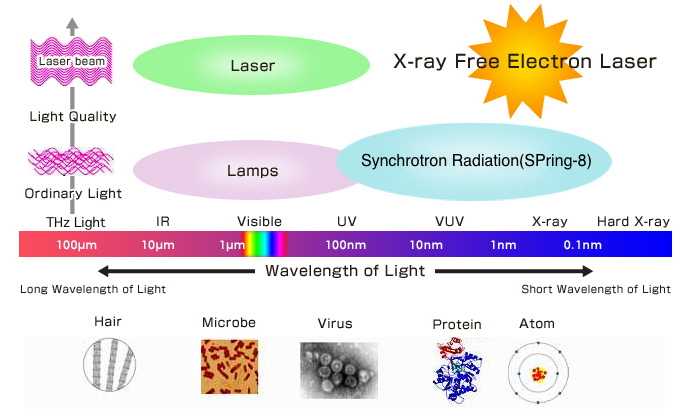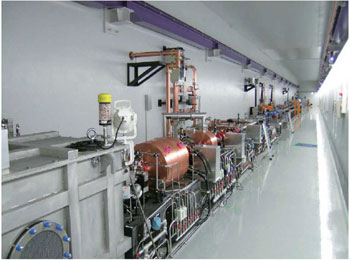
To gain a full understanding of physical and biological phenomena, we need to look at the
way atoms and molecules are structured and function, and how the electrons within them
move. Being able to directly observe the arrangement and movements of these atoms and
electrons would enable us to develop drugs for hard-to-cure diseases and treat harmful
chemicals that damage the environment, thus contributing to human welfare.
X-rays are one key to making this happen. Discovered in 1895 by Willhelm Roentgen,
x-rays are most well-known today for their use in hospitals. X-rays are light with a much
shorter wavelength than visible light. In addition to medical applications, they can be used
to examine microstructures at the atomic and molecular level. SPring-8, a synchrotron
facility, is one of the world’s most powerful x-ray sources, but it is still not powerful enough
to allow us to see the extremely rapid movements of atoms and molecules.
Lasers are another key to this goal. Researchers realized that if they could make a laser,
which emits a very powerful burst of concentrated light, emit x-ray light, they could use it
to observe the instantaneous movement of electrons and molecules. Lasers emit coherent
light (with the waves of the light matching one another), and can be used for a number of
optical technologies. X-ray lasers, however — while a longtime dream — have in the past
been beyond the reach of technology of the day.
Unlike traditional methods based on the light-emitting properties of materials, the building
of an x-ray laser requires accelerating electrons to high energies, manipulating their motion,
and using the light emitted during the process of acceleration. Since it is free electrons
removed from atoms that are used to produce the x-ray laser, this new type of device is
called an X-ray Free Electron Laser, or XFEL. This laser makes it possible for us to
observe atoms and molecules in real time.

High-energy electrons are passed through a series of alternating magnets known as
“undulators,” whereupon they emit light. The light attained through this process can range
in wavelength from terahertz to visible light, and further to x-rays. The electrons have
extremely high energy, and when the magnets in the undulator are spaced very closely
together, x-rays are emitted. This is also the way used to create x-ray light at the
SPring-8 synchrotron facility. At SPring-8, electrons pass through the undulator in an
uncoordinated fashion, so the light they emit is not coherent.
By placing resonant mirrors on both ends of the undulator, it is possible to make electrons
pass through the undulator in resonance with the wavelength of the emitted light, so that
the light emitted by the electrons becomes coherent. This method is normally used for
free-electron lasers that emit long wavelengths such as infrared and visible light.
This method cannot be used for the emission of short-wavelength x-rays, however, since it
is impossible to create mirrors that can reflect x-rays sufficiently well to create a resonator.
Fortunately, researchers in the 1980s envisioned the creation of an XFEL laser using the
concept of self-amplified spontaneous emission (SASE). Rather than having the electrons
oscillate through the resonator several times to increase interactions, the undulator is timed
so that the light emitted by electrons interferes with the electrons in front of them (because
photons always travel faster than electrons), leading to coherent x-rays.
All XFEL facilities active today make use of the SASE process. However, building an
XFEL based on this process requires a high-quality electron beam and precise control of
the electrons. The SACLA laser has successfully done this through a combination of
Japanese craftsmanship and scientific know-how.
 |
The SCSS
The SPring-8 Compact SASE Source is an experimental XFEL source approximately one-twelfth the size of SACLA (approximately 60 meters long). An electron gun emits electrons, which are accelerated along the linear accelerator and then passed through undulators which make them emit laser light (see photo). The electron energy is just 1/32 that of SACLA (250 MeV), but the basic equipment is the same. The successful operation of the experimental SCSS device established a proof-of-concept for the basic XFEL design. In addition, laser light emitted by SCSS was used for experiments that will later be conducted using SACLA. |
